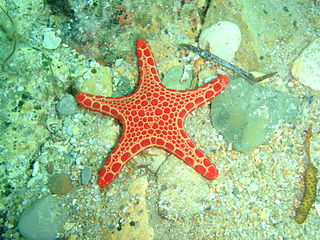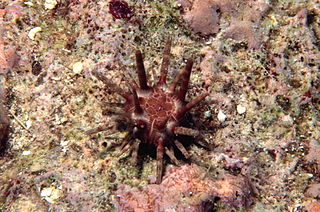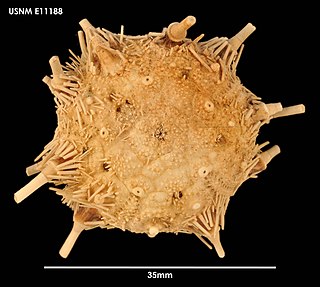
Cidaris is a genus of pencil sea urchins.

Goniasteridae constitute the largest family of sea stars, included in the order Valvatida. They are mostly deep-dwelling species, but the family also include several colorful shallow tropical species.

Coelopleurus is an extant genus of echinoids with fossil records dating back to the Eocene, with remains found in Europe and North America.

Eucidaris tribuloides, the slate pencil urchin, is a species of cidaroid sea urchins that inhabits littoral regions of the Atlantic Ocean. As a member of the basal echinoid order Cidaroida, its morphological, developmental and molecular genetic characteristics make it a phylogenetically interesting species.

Cidaroida, also known as pencil urchins, is an order of primitive sea urchins, the only living order of the subclass Perischoechinoidea. All other orders of this subclass, which were even more primitive than the living forms, became extinct during the Mesozoic.

Toxopneustidae is a family of globular sea urchins in the class Echinoidea.

Psychocidaridae is a family of sea urchins in the order Cidaroida. The genus Psychocidaris is extant while the other genera are only known from fossils. The family has been in existence since the Lower Jurassic (Toarcian) and the range includes Europe, Ukraine, North America, North Africa and the West Pacific.

Clypeaster, common name "cake urchins" or "sea biscuits", is a genus of echinoderms belonging to the family Clypeasteridae.

Eucidaris is a genus of cidaroid sea urchins known as slate pencil urchins. They are characterised by a moderately thick test, a usually monocyclic apical disc, perforate and non-crenulate tubercles and nearly straight ambulacra with horizontal pore pairs. The primary spines are few and widely spaced, stout with blunt flat tips and beaded ornamentation and the secondary spines are short and apressed. They originated in the Miocene and extant members of the genus are found in the tropical Indo-Pacific Ocean, East Pacific, Atlantic Ocean and Caribbean Sea.

Eucidaris metularia, the ten-lined urchin, is a species of sea urchins in the family Cidaridae. It is found in shallow parts of the Indo-Pacific Ocean and is characterised by its sparse covering of banded, flat-tipped spines.

Cidaris cidaris is a species of sea urchin commonly known as the long-spine slate pen sea urchin. It is found in deep water in the eastern Atlantic Ocean and the Mediterranean Sea.

Chondrocidaris gigantea, also known as the rough-spined urchin or blade-tipped tiara-urchin, is a species of sea urchin of the family Cidaridae. Chondrocidaris gigantea was first scientifically described in 1863 by Alexander Agassiz.
Chorocidaris micca is a species of sea urchins of the Family Cidaridae. Their armour is covered with spines. Chorocidaris micca was first scientifically described in 1941 by Ikeda.

Cidaris blakei is a species of sea urchins of the family Cidaridae. Its armour is covered with spines of three types, one unique type being extended and fan-like, making it easily recognized. Alexander Agassiz first described it scientifically in 1878. It is present on the seabed in deep waters in the Gulf of Mexico and the Bahamas.

Chaetodiadema is a genus of sea urchins of the Family Diadematidae. Their armour is covered with spines.

The Echinothuriidae are a family of sea urchins in the order Echinothurioida. Due to their soft skeletons, most are called "leather urchins", but species in the genus Asthenosoma are also known as "fire urchins" due to their bright colors and painful, venomous sting.

Aporocidaris is a genus of sea urchins in the family Ctenocidaridae. Several species are found in deep water in circum-Antarctic locations.

Dermechinus is a genus of sea urchin in the family Echinidae found in deep water in the southern Indian, Pacific and Atlantic Oceans. It is monotypic, with Dermechinus horridus, sometimes called the cactus urchin, being the only species.

The pourtalesiids (Pourtalesiidae) are a family of irregular sea urchins that live in the deep sea. They are secondarily bilateral-symmetrical and like other representatives of the taxon Holasteroida they lack the lantern of Aristotle, which is typical for many other sea urchins. The genus Pourtalesia was named after Louis-François de Pourtalès who first collected these animals while dredging at a depth of 600 m. The family is known already from the Upper Cretaceous (Maastrichtian) and is distributed worldwide.

Paleopneustina is a suborder of sea urchins of the order Spatangoida. Its taxonomy is still under investigation.



























